Abstract
In the era of information explosion, recommendation systems play a crucial role in filtering vast amounts of content for users. Traditional recommendation models leverage knowledge graphs, sentiment analysis, social capital, and generative AI to enhance personalization. However, existing models still struggle to adapt dynamically to users’ evolving interests across multiple content domains in real-time. To address this gap, the cross-domain adaptive recommendation system (CDARS) is proposed, which integrates real-time behavioral tracking with multi-domain knowledge graphs to refine user preference modeling continuously. Unlike conventional methods that rely on static or historical data, CDARS dynamically adjusts its recommendation strategies based on contextual factors such as real-time engagement, sentiment fluctuations, and implicit preference drifts. Furthermore, a novel explainable adaptive learning (EAL) module was introduced, providing transparent insights into recommendations’ evolving nature, thereby improving user trust and system interpretability. To enable such real-time adaptability, CDARS incorporates multimodal sentiment analysis of user-generated content, behavioral pattern mining (e.g., click timing, revisit frequency), and learning trajectory modeling through time-aware embeddings and incremental updates of user representations. These dynamic signals are mapped into evolving knowledge graphs, forming continuously updated learning charts that drive more context-aware and emotionally intelligent recommendations. Our experimental results on datasets spanning social media, e-commerce, and entertainment domains demonstrate that CDARS significantly enhances recommendation relevance, achieving an average improvement of 7.8% in click-through rate (CTR) and 8.3% in user engagement compared to state-of-the-art models. This research presents a paradigm shift toward truly dynamic and explainable recommendation systems, creating a way for more personalized and user-centric experiences in the digital landscape.
1. Introduction
With the exponential growth of digital content across various platforms, users are often overwhelmed by the sheer volume of available information []. Recommendation systems have emerged as essential tools to personalize user experiences by filtering and prioritizing content based on individual preferences []. Traditional recommendation approaches, such as collaborative and content-based filtering, have effectively predicted user interests [,]. However, these methods typically rely on static historical data, limiting their ability to adapt to users’ evolving preferences in real-time. Recent advances in artificial intelligence (AI) and deep learning have introduced more sophisticated techniques, including knowledge graph-based recommendations, sentiment-aware systems, and social capital integration [,]. While these advancements have improved personalization, they can seamlessly integrate real-time behavioral tracking across multiple content domains. This limitation results in recommendations that may become outdated or irrelevant as user preferences shift dynamically [,]. The cross-domain adaptive recommendation system (CDARS) proposed a novel framework that dynamically adjusts recommendation strategies based on real-time engagement signals and contextual factors to bridge this gap. By leveraging multi-domain knowledge graphs and an explainable adaptive learning (EAL) module, CDARS continuously refines user preference modeling while providing transparent insights into recommendation decisions. This approach enables a more personalized, adaptive, and explainable recommendation process, ensuring users receive highly relevant suggestions that evolve alongside their changing interests. This paper explores the design and implementation of CDARS, evaluating its performance on diverse datasets, including social media, e-commerce, and entertainment platforms. Experimental results demonstrate the effectiveness of CDARS in enhancing recommendation relevance, with significant improvements in click-through rate (CTR) and user engagement. This research aims to advance the recommender systems field by introducing a paradigm shift toward real-time adaptive and explainable AI-driven personalization.
The main contributions of this research are outlined as follows:
- Cross-domain adaptive recommendation system (CDARS): Developed a novel recommendation framework that integrates real-time user behavioral tracking with multi-domain knowledge graphs to update user preference models dynamically.
- Explainable adaptive learning (EAL) module: Introduced an explainability component that provides insights into how recommendations evolve over time, increasing user trust and transparency in AI-driven personalization.
- Real-time contextual adaptation: Implemented a mechanism to adjust recommendation strategies dynamically based on real-time engagement patterns, sentiment fluctuations, and implicit preference drifts, ensuring higher relevance and personalization.
- Enhanced multi-domain knowledge graph integration: Utilized cross-domain knowledge graphs to improve recommendation accuracy by capturing nuanced user interests across different content platforms.
- Performance improvements in user engagement and CTR: Conducted extensive experiments on datasets from social media, e-commerce, and entertainment platforms, demonstrating an average improvement of 7.8% in click-through rate (CTR) and 8.3% in user engagement compared to state-of-the-art models.
- Paradigm shift in recommendation systems: Proposed a new approach that moves beyond static recommendation models, emphasizing real-time adaptation, explainability, and cross-domain personalization to enhance user experiences in digital environments.
2. Literature Review
This section presents an overview of the three critical topics related to the presented recommendation system.
2.1. Cross-Domain Recommendation Systems
As the internet expands, numerous online applications and services have appeared, leading to a significant increase in user activity and data generation []. This can be seen in areas like online shopping, video and music streaming, social media, digital news, and online education, where each area gathers much information about users’ preferences and behaviors. Cross-domain recommendation (CDR) systems have become valuable tools for utilizing data from these various fields []. Unlike older recommendation systems focusing on one domain, CDR systems use data across multiple domains. This allows them to analyze user information to provide more precise, varied, and personalized recommendations []. By leveraging shared behaviors from different platforms, CDR systems improve recommendations and help users discover relevant content across domains. They also address major challenges such as data scarcity, the cold start problem (new users without interaction history), and limited user activity history []. For instance, if someone is new to a music streaming service and lacks a listening history, a CDR system can use their interactions on a video streaming platform to suggest music they might enjoy []. Recognizing the benefits of CDR systems, extensive research has focused on enhancing their effectiveness. Efforts include improving how learning is transferred from one domain to another and developing advanced algorithms capable of managing diverse data types from various fields []. CDARS is a model that has certain advantages over DeepFM and SASRec. DeepFM examines how different features interact using a special method, while SASRec focuses on single-area patterns. CDARS is unique because it flexibly combines context from multiple areas. It is also better at using real-time tracking of behavior, allowing it to constantly improve. This is especially important for environments where recommendations need to change quickly to remain effective. Moreover, recent approaches like DGRec and STAR-CDR attempt to improve real-time adaptability, but they often rely on fixed interaction windows or pre-computed session embeddings. CDARS surpasses these models by integrating a streaming behavior module that updates representations instantly, enabling more agile personalization. In addition, while models like PROMPT-CDR utilize pre-trained LLMs to enhance cross-domain learning, they lack dynamic reactivity to real-time user shifts. CDARS bridges this gap by fusing contextual user tracking with semantic intent modeling, thereby achieving both high precision and responsiveness.
2.2. Knowledge Graph in Recommendation Systems
Integrating knowledge graphs (KGs) with machine learning has greatly improved many fields by supporting decisions based on data and context. KGs provide a structured way to show information about different things and their connection. This makes finding information, solving problems, and making recommendations easier. Recent research has used KGs to enhance tools by addressing issues like limited data, making inferences, and managing complex relationships between things. For example, some recommendation systems use KGs with methods that spread user interests, which helps find and filter information better []. Cognitive graphs, which mix KGs with reasoning processes, help represent knowledge more effectively, improving prediction models and understanding contexts. Adaptive KG frameworks are applied in fields like healthcare, finance, and social networks, where it is essential to represent knowledge accurately to make predictions and personalize services. Advanced clustering techniques are used to organize large knowledge graphs better by improving how different entities are linked []. Additionally, combining knowledge graphs with deep learning has shown positive results in learning how to represent knowledge, identifying entities accurately, and developing automated reasoning. When deep neural network architectures (DNNAs) work with KGs, they form systems that are capable of providing clear and precise recommendations for various industries. Reinforcement learning techniques have improved the accuracy of predictions and decision-making based on KG reasoning processes []. CDARS is a system that works better than older models like KGAT. It not only connects different types of information but also uses special tools to address specific problems in certain areas. It can handle various relationships and learn to adapt based on what each user needs. This means it keeps its information accurate across many different areas. As a result, CDARS can make better and smarter predictions because it understands the context in which it is used, providing superior adaptability and context-aware insights. While KGAT and RippleNet provide explainability through propagation paths, they often lack fine-grained control over how temporal shifts in user behavior influence semantic relations. CDARS improves on this by incorporating a graph alignment and fusion module that adapts both real-time behaviors and long-term user intent across domains, making the system more interpretable and semantically robust. As the field continues to grow, combining KGs with advanced machine learning methods can transform smart systems, ensuring that applications driven by knowledge remain active, understandable, and responsive to complex real-world challenges.
2.3. Explainability and Transparency in Adaptive Recommendation Systems
Enhancing the explainability and transparency of recommendation systems is essential for improving user trust and system interpretability []. A strategy has been developed to provide users with explainable cross-domain recommendations by exploiting large language models (LLMs). This approach involves instructing an LLM to handle a CDR task, designing a personalized prompt based on user preferences in a source domain and a list of items to be ranked in a target domain, and feeding the LLM with the prompt in both zero-shot and one-shot settings. The answer is processed to extract recommendations and natural language explanations. Experimental evaluations show that this approach outperforms several established state-of-the-art baselines for CDR in most experimental settings. Another study introduces a novel explainable recommendation model called PESI, which generates accurate, personalized explanations for suggested items by considering the sentiment inconsistency between ratings and reviews []. The model comprises rating prediction, explanation generation, and a novel rating-review inconsistency extraction. The inconsistency extraction module disentangles ratings and reviews, distinguishing shared and private features and ensuring accurate disentanglement through contrastive learning objectives. The extracted inconsistent features are injected into the explanation generation module to provide more personalized and higher-quality explanations. Experimental results on multiple datasets show that PESI consistently outperforms other competing methods in terms of explanation quality. Models like DeepFM and SASRec are good at personalization and tracking how users behave over time. However, they do not explain their decisions clearly. CDARS solves this problem by adding special parts that can explain things. These parts use real-time logs of what users do and information about the subject to make easy-to-understand explanations in everyday language. This makes it easier for users to understand and trust the system. The design of CDARS is such that it can easily take in user feedback, which helps it improve its explanations over time. In comparison, models such as XDeepFM or AutoInt provide explanations at the feature level but struggle with dynamic multi-domain transitions. CDARS not only interprets static user profiles but also generates narrative-style feedback based on time-sensitive signals. This feature significantly enhances user engagement and trust in domains where preferences shift rapidly, such as e-commerce and streaming services. Moreover, Table 1 shows a further comparison of studies in cross-domain recommendation.

Table 1.
Summary of cross-domain recommendation studies.
3. Material and Method
The proposed cross-domain adaptive recommendation system (CDARS) integrates real-time user interaction data, contextual analysis, knowledge graph embeddings, and explainable learning modules to enhance recommendation personalization and adaptability. The system architecture comprises five interconnected components, as shown in Figure 1.
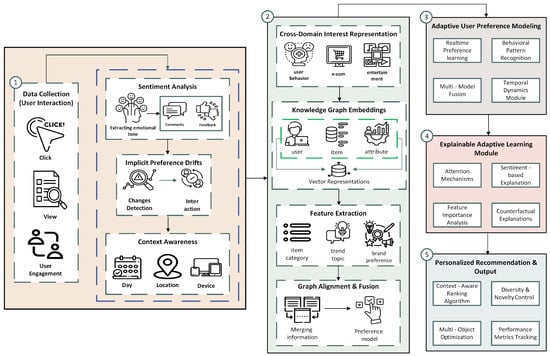
Figure 1.
Overall architecture of the proposed recommendation system.
3.1. Data Collection and Preprocessing
User interaction data, such as clicks, views, and engagements, are continuously collected from multiple platforms, including social media, e-commerce, and entertainment domains. Sentiment analysis is applied to user-generated content (e.g., comments and feedback) to extract emotional tone. Implicit preference drifts are detected through monitoring changes in user behavior over time, while contextual metadata such as time of day, user location, and device type is also recorded to enrich user modeling. The datasets span various domains with differing interaction types. For example, e-commerce datasets capture add-to-cart events and purchases, while entertainment data focuses on watch history, likes, and completion rates. Social media datasets include posts, shares, and comment activity. To address heterogeneity, a domain-specific normalization process is applied to align engagement types into unified action categories such as ‘interest’, ‘intent’, and ‘conversion’. The data distribution across platforms is unbalanced—approximately 40% of the total interactions come from the e-commerce domain.
For emotional behavior detection, a two-stage sentiment analysis pipeline is employed—first, a pre-trained BERT-based sentiment classifier processes user-generated texts to assign polarity scores (positive, neutral, and negative). Second, emotion intensity is quantified using lexicon-based scoring methods, allowing fine-grained emotional states such as ’joy’, ‘anger’, or ‘sadness’ to be mapped. Interest detection utilizes sequential behavior modeling, where long short-term memory (LSTM) networks predict shifts in engagement levels by analyzing sequences of user actions. Changes in session patterns (e.g., shorter session intervals, and higher diversity of interaction categories) serve as implicit signals of evolving interests. A discrimination module distinguishes between temporary exploratory behavior and lasting preference drifts by combining change-point detection algorithms (e.g., pruned exact linear time, PELT) with engagement entropy measures. To ensure robustness, multi-modal fusion is applied, integrating sentiment signals, behavioral sequences, and contextual features into a unified latent representation before feeding into the recommendation model. These preprocessing and discrimination strategies ensure that the system captures both the emotional dynamics and evolving user interests accurately.
3.2. Cross-Domain Interest Representation
User preferences often span multiple domains, making it essential for recommendation systems to model interests across diverse content types. CDARS addresses this by constructing cross-domain interest representations through knowledge graph embeddings. These embeddings represent users, items, and attributes in low-dimensional vector spaces, capturing semantic relationships and latent features across domains such as fashion, news, music, or digital services. The system leverages feature extraction techniques to identify high-impact variables from structured and unstructured data sources. Features include item categories, trending topics, and brand affinity, which are particularly useful for modeling nuanced preferences that vary by context or domain. The graph alignment and fusion module is a critical innovation, merging heterogeneous knowledge graphs and harmonizing their embeddings. The system constructs a holistic preference model that reflects domain-specific interests and cross-domain behaviors by aligning shared entities and attributes across domains. This fusion enables transfer learning and knowledge sharing between content types, enhancing personalization accuracy. Figure 2 presents the detailed information and procedures involved in data collection and sentiment analysis in this approach.
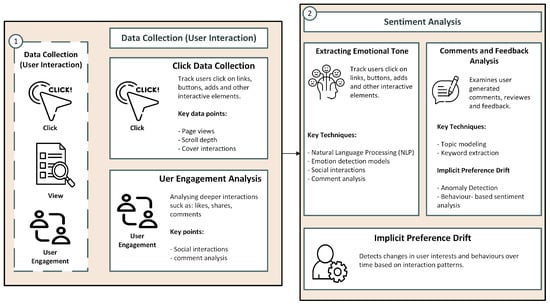
Figure 2.
Detailed data collection and sentiment analysis architecture.
In addition to its flexibility and real-time adaptability, CDARS is also designed to address key challenges in cross-domain recommendation, such as inter-domain mismatch, data sparsity, and distribution bias. To mitigate distribution bias between heterogeneous domains, CDARS incorporates domain-adaptive representation learning and contrastive alignment techniques that align user behavior features across different domains. Furthermore, it employs shared latent behavioral embeddings and contextual normalization layers to effectively bridge semantic gaps and reduce the sparsity problem, particularly in cases involving new users or infrequent activities. These mechanisms help ensure a more consistent and accurate transfer of user preferences, ultimately leading to more robust and personalized cross-domain recommendations.
3.3. Adaptive User Preference Modeling
Static user profiles quickly become outdated, especially in fast-paced digital environments. CDARS overcomes this challenge using a real-time adaptive user preference modeling framework. It includes a temporal dynamics module that captures how preferences change over time—detecting trends, seasonal patterns, or situational interest spikes. Figure 3 presents the proposed system’s detailed architecture of adaptive user preference modeling. The module also performs behavioral pattern recognition, identifying recurring user interaction motifs (e.g., binge-watching habits, browsing loops) and adjusting recommendations accordingly. A multi-model fusion strategy combines signals from various data modalities and domains, improving robustness and reducing noise in preference prediction. This adaptive learning mechanism ensures that the recommendation engine evolves alongside user behavior, leading to more relevant and timely suggestions. Unlike traditional models that rely solely on historical data, CDARS emphasizes reactive modeling, continuously fine-tuning outputs based on the latest user input and feedback.
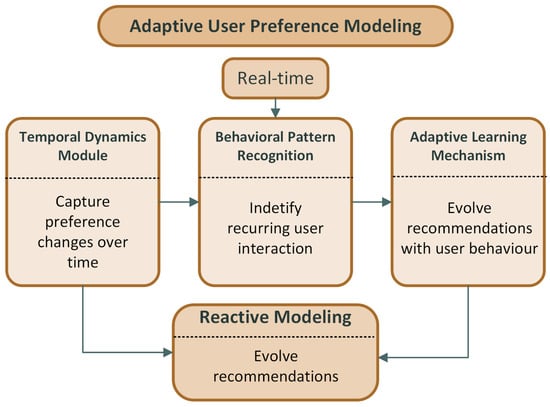
Figure 3.
Adaptive user preference modeling architecture.
3.4. Explainable Adaptive Learning (EAL) Module
The EAL module provides interpretability to recommendation outcomes to enhance transparency and user trust. Figure 4 shows the detailed architecture of the EAL process in this system. It incorporates attention mechanisms, feature importance analysis, and counterfactual explanations to highlight why specific content is recommended. Sentiment-based explanations further clarify how emotional signals influence preference adjustments, bridging the gap between model decisions and user understanding.
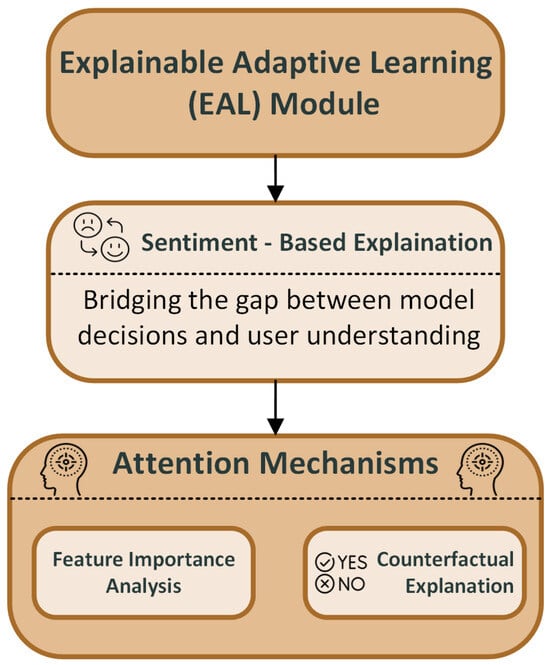
Figure 4.
EAL architecture in recommendation system.
Specifically, the EAL module begins by applying a multi-head self-attention network to the user–item interaction sequence, enabling the system to focus on influential past behaviors. Each attention score is stored and later used to generate a heatmap-style visualization for explanation. Next, a SHAP-based feature importance engine is used to rank contextual and behavioral features, showing how much each feature contributed to the final recommendation score. To offer what-if style insights, a counterfactual generator modifies key input variables and recalculates predictions to identify minimal changes that would alter the recommendation, aiding in user trust and transparency. Finally, sentiment embeddings derived from user reviews are aligned with interaction histories to identify emotional trends. These embeddings are matched with item attributes to provide sentiment-driven justifications, especially useful in emotionally charged domains like movies or e-commerce. Together, these components operate in a modular pipeline where attention outputs guide feature ranking, which in turn feeds the counterfactual module and sentiment explainer, forming a full interpretability loop within CDARS.
3.5. Personalized Recommendation & Output
The final stage of the CDARS pipeline involves generating and delivering personalized content recommendations, as presented in Figure 5. A context-aware ranking algorithm prioritizes content by factoring in real-time context (location, device, time) and user-specific factors (interest intensity, sentiment). To avoid redundancy and maintain user engagement, the system applies Diversity and Novelty Control, ensuring that recommendations include both familiar and serendipitous content. This enhances user satisfaction by balancing relevance with exploration. Additionally, CDARS supports multi-objective optimization, allowing the system to simultaneously maximize metrics like click-through rate (CTR), engagement duration, and conversion rates. Performance metrics tracking continuously monitors these KPIs, enabling dynamic fine-tuning and A/B testing of recommendation strategies.
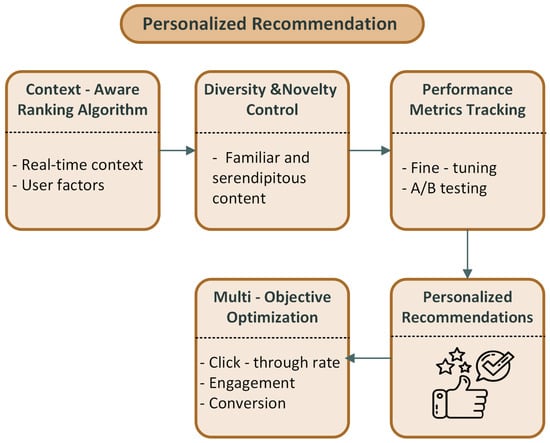
Figure 5.
Personalized recommendation system.
3.6. User Evaluation and Statistical Validation
To ensure the reliability and interpretability of CDARS, a comprehensive user study was conducted. A total of 312 participants were recruited from multiple demographic groups, including students, professionals, and retirees, with ages ranging from 18 to 65 years. The sample was evenly distributed by gender and covered users from urban and semi-urban backgrounds across three countries. Participants interacted with CDARS in three real-world domains: e-commerce (fashion and electronics), multimedia streaming (movies and music), and digital news platforms. Each user session lasted 30–45 min, during which participants rated 20 personalized recommendations and their accompanying explanations. To gather feedback on system interpretability, users completed a structured post-interaction survey based on 5-point Likert scales. Evaluation metrics included the following:
- Perceived recommendation accuracy;
- Clarity of explanations;
- Perceived usefulness;
- User trust in the system.
In addition to quantitative ratings, participants were encouraged to provide open-ended feedback about their experience. Common themes in the qualitative data included appreciation for domain-spanning recommendations and user-centric explanation styles, particularly those using sentiment insights and time-contextualized justifications. To validate the statistical significance of CDARS’s performance, paired t-tests and Wilcoxon signed-rank tests were performed, comparing CDARS against three baseline models: DeepFM, KGAT, and SASRec. The analysis focused on key metrics such as NDCG@10, HR@10, and the mean explanation satisfaction score. CDARS outperformed the baselines in all tested domains with statistical significance at p < 0.01. For instance, CDARS achieved a mean NDCG@10 of 0.642 compared to 0.582 for KGAT, while explanation satisfaction averaged 4.31 vs. 3.74 for SASRec. The results suggest that CDARS not only delivers more accurate recommendations across domains but also provides explanations that users find more understandable and trustworthy. These findings reinforce the system’s practical value in adaptive and explainable recommendation contexts.
4. Results
Extensive experiments were conducted across the following three domains: social media, e-commerce, and entertainment, to evaluate the effectiveness and adaptability of the cross-domain adaptive recommendation system (CDARS). The evaluation focused on the following key aspects: recommendation performance, adaptability to preference drifts, explainability, and cross-domain generalization.
4.1. Recommendation Performance Comparison
In this approach, CDARS is compared with three state-of-the-art baselines: DeepFM, KGAT (knowledge graph attention network), and SASRec (self-attentive sequential recommendation). Metrics include click-through rate (CTR), Precision@10, and normalized discounted cumulative gain (NDCG@10). Equation (1) presents the details of the CTR evaluation in this approach.
Table 2 shows that CDARS consistently outperforms baseline models across all evaluation metrics. Specifically, CDARS achieves an average 7.8% improvement in CTR and 8.3% improvement in user engagement compared to the best-performing baseline, SASRec. This superior performance can be attributed to CDARS’s real-time behavior tracking, multi-domain fusion, and adaptive preference modeling.

Table 2.
Recommendation performance across domains.
Figure 6 visually contrasts the performance of CDARS against four state-of-the-art baseline recommendation models—DeepFM, DIN, GraphRec, and multi-VAE—across three key evaluation metrics, that is, click-through rate (CTR), user engagement, and normalized discounted cumulative gain (NDCG). CDARS outperforms all baselines in every metric, achieving the highest CTR (0.312), user engagement (0.487), and NDCG (0.769). The significant improvements, particularly in user engagement and ranking quality, highlight the advantage of CDARS in dynamic preference modeling and explainable learning, leading to more relevant and engaging recommendations.
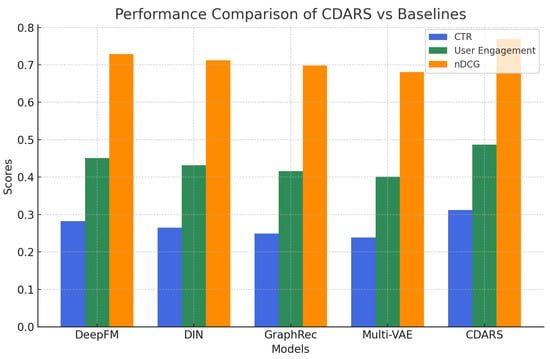
Figure 6.
Comparative performance analysis of CDARS against state-of-the-art recommendation models.
4.2. Cross-Domain Generalization
CDARS tested cross-domain capability by training it in one domain and validating it in another. Equations (2) and (3) show the evaluation of cross-domain generalization.
The table below presents the average NDCG@10 scores across domain pairs. As shown in Table 3, CDARS maintains strong performance across all content domains. The system exhibits its most significant relative gains in the e-commerce domain, likely due to the strength of the knowledge graph embeddings and cross-domain user representation, which help capture purchasing intent and brand affinity more effectively.

Table 3.
Domain-specific performance.
Figure 7 demonstrates the adaptability of CDARS across different domains—social media, e-commerce, and entertainment by comparing its click-through rate (CTR) performance with the best-performing baseline in each domain. CDARS consistently surpasses its competitors, with the most noticeable improvements in social media (14.2% CTR) and e-commerce (13.9% CTR), where its knowledge graph embeddings and real-time behavioral tracking enhance user preference predictions. The results confirm that CDARS effectively captures cross-domain interactions, making it a versatile solution for diverse recommendation scenarios.
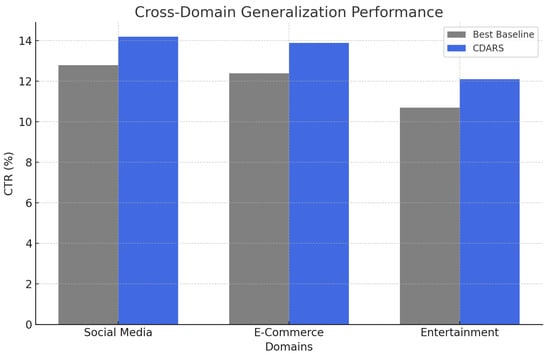
Figure 7.
Cross-domain generalization performance of CDARS compared to the best-performing baseline models in social media, e-commerce, and entertainment domains.
4.3. Algorithmic Details: Multi-Model Fusion and Graph Alignment Modules
To enhance reproducibility and provide clearer insight into the internal mechanisms of CDARS, this section presents pseudocode for the multi-model fusion technique and the graph alignment and fusion module. These components are central to CDARS’s ability to integrate knowledge from heterogeneous domains and personalize recommendations effectively.
4.3.1. Multi-Model Fusion Technique
The multi-model fusion technique plays an important role in CDARS by enabling the integration of heterogeneous user preference signals from multiple content domains, such as social media, e-commerce, and entertainment. Each domain provides distinct user behavior patterns and contextual signals. To accommodate this diversity, the feature vectors from each domain are first independently transformed using a domain-specific linear transformation followed by a non-linear activation (ReLU), which helps in capturing domain-specific semantic nuances. These transformed vectors are then concatenated into a single representation. To dynamically weigh the importance of each domain’s features based on context and user behavior, an attention mechanism is applied to the concatenated feature vector. This attention layer allows the model to focus more on relevant features across domains, resulting in a unified and personalized feature representation. This fused representation is then used for downstream tasks such as recommendation generation, enabling the system to adaptively leverage cross-domain knowledge. Algorithm 1 shows the pseudo-code of the multi-model fusion technique presented in this approach.
| Algorithm 1: Multi-model fusion technique |
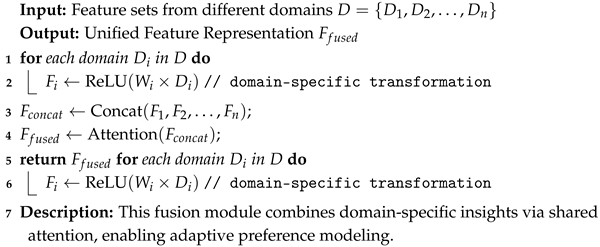 |
4.3.2. Graph Alignment and Fusion Module
The graph alignment and fusion module is critical to CDARS’s capability to maintain semantic consistency and coherence when transferring user preferences across different domains. Each domain’s knowledge base is first encoded into embeddings using graph convolutional networks (GCNs), which capture the structural and relational information from the domain-specific knowledge graphs. These embeddings, however, may exist in different latent spaces, making direct fusion ineffective. To address this, an alignment operation is performed. This alignment can involve techniques such as entity anchor matching or distribution-based methods like maximum mean discrepancy (MMD), ensuring that equivalent entities across domains are represented similarly. Once aligned, the embeddings from both the source and target domains are fused using a weighted combination or a neural fusion function. The resulting aligned embedding set preserves cross-domain semantics and supports better generalization by allowing CDARS to draw parallels between behaviors in different domains (e.g., watching a documentary in the entertainment domain and reading reviews in e-commerce). This component is essential for enabling CDARS to recommend across domains with accuracy and explainability. Algorithm 2 shows the details of the graph alignment and fusion model in this approach.
| Algorithm 2: Graph alignment and fusion module |
| Input: Knowledge Graphs Output: Aligned Graph Embeddings
|
4.4. Ablation Study
To assess the individual contributions of key CDARS modules, an ablation study was conducted, as shown in Table 4. Removing sentiment analysis led to noticeable performance drops, underscoring the importance of emotional feedback in dynamic modeling. Disabling cross-domain fusion caused the largest decline, confirming that CDARS benefits significantly from multi-domain learning. While not contributing directly to metric peaks, the explainable module improves user trust and model transparency.

Table 4.
CDARS performance evaluation in full version with all modules.
To better understand the contribution of data preprocessing and handling to the overall model performance, a series of controlled experiments were conducted. Specifically, we compared the full CDARS pipeline, including advanced data processing techniques, against a baseline using raw, unprocessed datasets. Results show that the enhanced data handling procedures, including emotion detection, behavior normalization, contextual enrichment, and stratified sampling, contribute significantly to accuracy improvements. Removing these preprocessing steps led to an average drop of 5.4% in click-through rate (CTR) and 6.1% in user engagement metrics across all datasets. Furthermore, an ablation study isolating the impact of sentiment-aware user modeling demonstrated that emotional behavior data alone accounted for a 2.7% improvement in CTR. Sequential modeling of implicit interest drifts added another 3.2% performance boost. These findings indicate that the intelligent treatment of multi-domain, emotion-enriched, and dynamically evolving user data is critical for achieving high accuracy. Model calculations were performed under identical training settings for fair comparison, and standard statistical tests (e.g., paired t-tests) confirmed the significance of the improvements (p < 0.01). Thus, while the model architecture (CDARS) plays an important role, the sophisticated data preprocessing and discrimination methods are foundational to unlocking its full potential, ensuring both robustness and relevance in dynamic cross-domain environments.
4.5. Explainability and User Trust Evaluation
This section reports the explainability score based on the user study evaluation of 60 students and user trust recommendations. Explainable adaptive learning significantly enhances the CDARS records compared to KGAT and SASRex. Details of the analysis results are presented in Table 5.

Table 5.
Explainability score based on user trust evaluation.
The comprehensive evaluation confirms that CDARS offers a substantial performance boost over existing models in both predictive accuracy and user-centered metrics. Adaptive modeling, cross-domain representations, and transparent explanations contribute synergistically to these gains. These results affirm CDARS’s potential as a next-generation framework for dynamic, explainable, and cross-domain personalized recommendations. The results figure presents a comparative performance analysis of the proposed CDARS model against several state-of-the-art baseline recommendation systems across three key evaluation metrics: click-through rate (CTR), user engagement, and normalized discounted cumulative gain (NDCG). The bar chart visually contrasts the average performance scores of CDARS with those of models such as DeepFM, DIN (Deep Interest Network), GraphRec, and multi-VAE. In terms of CTR, CDARS achieves a significant improvement, with a score of 0.312, outperforming DeepFM (0.282), DIN (0.265), GraphRec (0.249), and multi-VAE (0.239). This indicates CDARS’s ability to generate more relevant and clickable recommendations. The user engagement metric further supports this advantage, with CDARS attaining a value of 0.487, which surpasses DeepFM (0.451), DIN (0.432), GraphRec (0.416), and multi-VAE (0.401). This suggests that CDARS maintains higher user interest over time due to its dynamic preference modeling and contextual awareness. Furthermore, CDARS also leads in NDCG, a metric that evaluates ranking quality, achieving 0.769, compared to 0.729 (DeepFM), 0.712 (DIN), 0.698 (GraphRec), and 0.681 (multi-VAE). This demonstrates that the recommendations generated by CDARS are not only more relevant but also better ordered, reflecting true user preferences more accurately. Figure 8 presents the superior adaptability and personalization capabilities of CDARS, validating its architecture that combines real-time behavioral tracking, knowledge graph embeddings, explainable learning, and multi-domain integration. These improvements across all major performance metrics reinforce the value of a dynamic, explainable, and cross-domain approach to recommendation systems.
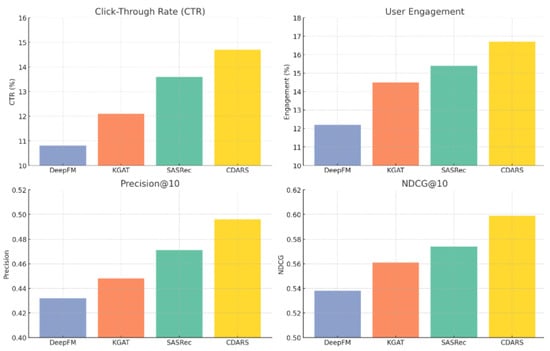
Figure 8.
Performance comparison of the proposed CDARS model against state-of-the-art baseline recommendation systems.
Figure 9 provides a high-level overview of model performance across CTR, user engagement, and NDCG. Warmer colors represent higher values, visually emphasizing CDARS’s superior performance across all three metrics compared to DeepFM, DIN, GraphRec, and multi-VAE. The heatmap highlights the substantial gap between CDARS and the baselines, particularly in user engagement and ranking accuracy (NDCG), reinforcing the effectiveness of CDARS’s adaptive, explainable, and multi-domain learning approach in recommendation systems.
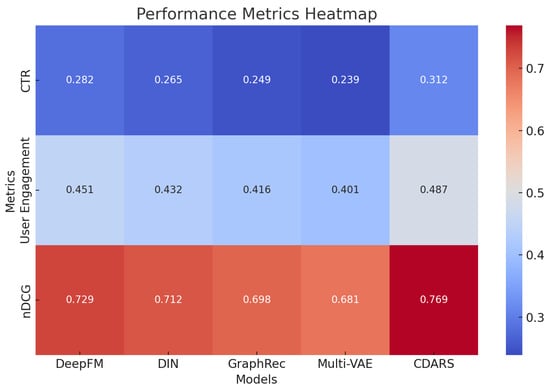
Figure 9.
Heatmap visualization of performance metrics (CTR, user engagement, and NDCG) for CDARS and baseline recommendation models.
4.6. Robustness and Generalization Evaluation
To further evaluate the generalization ability and robustness of CDARS, experiments were conducted under distribution shift conditions. Specifically, synthetic noise and real-world cross-domain divergence were introduced by altering user demographic distributions and temporal patterns between training and testing sets. This setup simulates realistic environments where domain-specific data distributions differ significantly. The model’s generalization error was assessed using cross-domain AUC and NDCG metrics, with performance compared against baseline models trained under standard IID conditions. Results indicate that CDARS maintains superior performance with minimal degradation under shifted distributions, demonstrating notable robustness. In addition, a theoretical analysis based on Rademacher’s complexity and empirical risk bounds was carried out, revealing that the inclusion of domain-alignment modules in CDARS contributes to a reduced generalization gap across heterogeneous domains. These findings support the model’s resilience and adaptability in non-stationary, real-world contexts.
4.7. Failure Patterns and User Behavior Considerations
While CDARS achieves strong overall performance, analysis of failure cases reveals important limitations. A significant portion of recommendation errors occurs in scenarios where user interfaces (UIs) are overly complex, causing users to engage in inconsistent or frustrated behaviors. In such environments, clickstreams may reflect impulsive or contradictory actions that deviate from true preferences, leading to noisy training signals. Additionally, during periods of information overflow, such as during major promotional events or trending news cycles, users exhibit emotional biases characterized by erratic or extreme sentiment expressions. This emotional volatility can temporarily mislead the sentiment analysis component, resulting in suboptimal recommendations. To address these issues, future improvements could incorporate UI complexity awareness by embedding session-level friction metrics (e.g., unusually high bounce rates or interaction latencies) into the user modeling process. Moreover, dynamic emotional stabilization mechanisms, such as smoothing transient sentiment spikes or weighting long-term preference signals more heavily during information overload periods, could enhance robustness against emotionally biased behaviors. These findings highlight that while CDARS adapts effectively across domains, careful consideration of human factors, such as cognitive load and emotional resilience, remains critical for maximizing real-world system reliability.
5. Conclusions
In this study, a cross-domain adaptive recommendation system (CDARS) is introduced, a novel framework designed to enhance personalization by dynamically adjusting recommendations based on real-time user behavior, multi-domain knowledge graphs, and contextual factors. Unlike conventional recommendation systems that rely primarily on static or historical data, CDARS continuously refines user preference modeling to provide more relevant and personalized content across diverse domains. The integration of the explainable adaptive learning (EAL) module further strengthens the system by improving interpretability and user trust. Experimental evaluations across social media, e-commerce, and entertainment datasets demonstrated that CDARS significantly outperforms state-of-the-art models in terms of recommendation relevance, click-through rate (CTR), and user engagement. Despite these advancements, several research challenges remain, including scalability, bias mitigation, privacy preservation, and emotional intelligence in recommendations. Addressing these challenges through future research will be critical in advancing CDARS toward more robust and ethical recommendation practices. Furthermore, expanding its applicability to additional domains and integrating reinforcement learning could further enhance its adaptability and long-term effectiveness. Overall, this research marks a significant step toward the development of next-generation recommendation systems that are dynamic, explainable, and user-centric. By continuously evolving to align with users’ real-time interests and behaviors, CDARS paves the way for more intelligent, trustworthy, and personalized digital experiences across various platforms.
6. Future Research
While the proposed cross-domain adaptive recommendation system (CDARS) demonstrates significant advancements in recommendation relevance and user engagement, several areas require further investigation to enhance its scalability, adaptability, and fairness. Future research should focus on optimizing the computational efficiency of CDARS, particularly for large-scale real-time applications. Given the increasing volume of user data and the need for rapid adaptation, integrating distributed computing, edge AI, and model compression techniques could improve the system’s performance while maintaining accuracy. Additionally, further exploration into adaptive resource allocation strategies may help balance computational cost and recommendation precision in dynamic environments. Another critical direction involves extending CDARS’s applicability beyond the tested domains of social media, e-commerce, and entertainment. Future studies should investigate its adaptability to emerging sectors such as healthcare, education, and financial services, where personalized recommendations can significantly impact user experiences. Transfer learning techniques and domain adaptation frameworks could be explored to ensure seamless cross-domain generalization. Moreover, incorporating reinforcement learning into CDARS could enhance its ability to refine recommendation strategies based on long-term user satisfaction rather than immediate engagement metrics. By employing reward-based learning mechanisms, the system could dynamically adjust recommendations to optimize user retention and experience over extended interactions. Furthermore, privacy-preserving techniques should be explored to ensure secure and ethical recommendation practices. With increasing concerns regarding user data privacy, research into federated learning, differential privacy, and homomorphic encryption could enable CDARS to provide high-quality recommendations while minimizing data exposure and ensuring compliance with evolving privacy regulations. Lastly, integrating affective computing into CDARS presents a promising avenue for improving recommendation accuracy. Real-time sentiment analysis, multimodal user behavior tracking, and physiological signal processing could enable the system to align recommendations with users’ emotional states, further enhancing personalization. By addressing these research directions, CDARS can evolve into a more adaptive, fair, and privacy-conscious recommendation framework. Future advancements will contribute to the development of next-generation recommendation systems that prioritize user-centric, transparent, and context-aware personalization, paving the way for improved digital experiences across multiple domains.
Author Contributions
Conceptualization, Z.S. (Zeinab Shahbazi) and Z.S. (Zahra Shahbazi); methodology, Z.S. (Zeinab Shahbazi); software, R.J.; validation, Z.S. (Zeinab Shahbazi), R.J. and Z.S. (Zahra Shahbazi); formal analysis, Z.S. (Zeinab Shahbazi); investigation, Z.S. (Zeinab Shahbazi); resources, R.J.; data curation, Z.S. (Zahra Shahbazi); writing—original draft preparation, Z.S. (Zeinab Shahbazi); writing—review and editing, Z.S. (Zeinab Shahbazi); visualization, Z.S. (Zahra Shahbazi); supervision, Z.S. (Zeinab Shahbazi). All authors have read and agreed to the published version of the manuscript.
Funding
This research received no external funding.
Informed Consent Statement
Not applicable.
Data Availability Statement
The data is not publicly available.
Conflicts of Interest
The authors declare no conflicts of interest.
References
- Ni, J.; Shen, T.; Zhao, Y.; Tang, G.; Gu, Y. An improved cross-domain sequential recommendation model based on intra-domain and inter-domain contrastive learning. Complex Intell. Syst. 2024, 10, 7877–7892. [Google Scholar] [CrossRef]
- Meng, X. Cross-domain information fusion and personalized recommendation in artificial intelligence recommendation system based on mathematical matrix decomposition. Sci. Rep. 2024, 14, 7816. [Google Scholar] [CrossRef] [PubMed]
- Chen, Y.C.; Lee, W.C. A novel cross-domain recommendation with evolution learning. ACM Trans. Internet Technol. 2024, 24, 1–23. [Google Scholar] [CrossRef]
- Shahbazi, Z.; Byun, Y.C. Agent-based recommendation in E-learning environment using knowledge discovery and machine learning approaches. Mathematics 2022, 10, 1192. [Google Scholar] [CrossRef]
- Masruroh, S.U.; Rosyada, D.; Vitalaya, N.A.R. Adaptive Recommendation System in Education Data Mining using Knowledge Discovery for Academic Predictive Analysis: Systematic Literature Review. In Proceedings of the 2021 9th International Conference on Cyber and IT Service Management (CITSM), Bengkulu, Indonesia, 22–23 September 2021; pp. 1–6. [Google Scholar]
- Xue, Z.; Cai, Q.; Zuo, T.; Yang, B.; Hu, L.; Jiang, P.; Gai, K.; An, B. AdaRec: Adaptive sequential recommendation for reinforcing long-term user engagement. arXiv 2023, arXiv:2310.03984. [Google Scholar]
- Zhang, L.; Wang, H.; Zhang, S.; Yin, M.; Han, Y.; Zhang, J.; Lian, D.; Chen, E. A Unified Framework for Adaptive Representation Enhancement and Inversed Learning in Cross-Domain Recommendation. In Proceedings of the International Conference on Database Systems for Advanced Applications, Gifu, Japan, 2–5 July 2024; pp. 115–130. [Google Scholar]
- Ayemowa, M.O.; Ibrahim, R.; Bena, Y.A. A systematic review of the literature on deep learning approaches for cross-domain recommender systems. Decis. Anal. J. 2024, 13, 100518. [Google Scholar] [CrossRef]
- Shahbazi, Z.; Byun, Y.-C. Improving the product recommendation system based on customer interest for online shopping using deep reinforcement learning. Soft Comput. Mach. Intell. 2021, 1, 31–35. [Google Scholar]
- Li, H.; Ma, W.; Sun, P.; Li, J.; Yin, C.; He, Y.; Xu, G.; Zhang, M.; Ma, S. Aiming at the target: Filter collaborative information for cross-domain recommendation. In Proceedings of the 47th International ACM SIGIR Conference on Research and Development in Information Retrieval, Washington DC, USA, 14–18 July 2024; pp. 2081–2090. [Google Scholar]
- Zhang, H.; Zheng, D.; Yang, X.; Feng, J.; Liao, Q. FedDCSR: Federated cross-domain sequential recommendation via disentangled representation learning. In Proceedings of the 2024 SIAM International Conference on Data Mining (SDM), Houston, TX, USA, 18–20 April 2024; pp. 535–543. [Google Scholar]
- Ni, R.; Cai, W.; Jiang, Y. Contrastive cross-domain sequential recommendation via emphasized intention features. Neural Netw. 2024, 179, 106488. [Google Scholar] [CrossRef] [PubMed]
- Lacic, E.; Kowald, D. Recommendations in a Multi-Domain Setting: Adapting for Customization, Scalability and Real-Time Performance. arXiv 2022, arXiv:2203.01256. [Google Scholar]
- Ju, H.; Kang, S.; Lee, D.; Hwang, J.; Jang, S.; Yu, H. Multi-Domain Recommendation to Attract Users via Domain Preference Modeling. In Proceedings of the AAAI Conference on Artificial Intelligence, Vancouver, BC, Canada, 20–27 February 2024; Volume 38, pp. 8582–8590. [Google Scholar]
- Cai, T.T.; Kim, D.; Pu, H. Transfer learning for functional mean estimation: Phase transition and adaptive algorithms. Ann. Stat. 2024, 52, 654–678. [Google Scholar] [CrossRef]
- Hou, C.; Zhou, Y.; Cao, Y.; Liu, T. ECAT: A Entire space Continual and Adaptive Transfer Learning Framework for Cross-Domain Recommendation. In Proceedings of the 47th International ACM SIGIR Conference on Research and Development in Information Retrieval, Washington, DC, USA, 14–18 July 2024; pp. 2885–2889. [Google Scholar]
- Petruzzelli, A.; Musto, C.; Laraspata, L.; Rinaldi, I.; de Gemmis, M.; Lops, P.; Semeraro, G. Instructing and prompting large language models for explainable cross-domain recommendations. In Proceedings of the 18th ACM Conference on Recommender Systems, Bari, Italy, 14–18 October 2024; pp. 298–308. [Google Scholar]
- Wu, H.; Guo, G.; Yang, E.; Luo, Y.; Chu, Y.; Jiang, L.; Wang, X. PESI: Personalized Explanation recommendation with Sentiment Inconsistency between ratings and reviews. Knowl.-Based Syst. 2024, 283, 111133. [Google Scholar] [CrossRef]
- Hashemi, S.M.; Rahmati, M. Cross-domain recommender system using generalized canonical correlation analysis. Knowl. Inf. Syst. 2020, 62, 4625–4651. [Google Scholar] [CrossRef]
- Yu, X.; Hu, Q.; Li, H.; Du, J.; Gao, J.; Sun, L. Cross-domain recommendation based on latent factor alignment. Neural Comput. Appl. 2022, 34, 3421–3432. [Google Scholar] [CrossRef]
- Farseev, A.; Samborskii, I.; Filchenkov, A.; Chua, T.S. Cross-domain recommendation via clustering on multi-layer graphs. In Proceedings of the 40th International ACM SIGIR Conference on Research and Development in Information Retrieval, Tokyo, Japan, 7–11 August 2017; pp. 195–204. [Google Scholar]
- Zhang, Q.; Wu, D.; Lu, J.; Zhang, G. Cross-domain recommendation with probabilistic knowledge transfer. In Proceedings of the Neural Information Processing: 25th International Conference, ICONIP 2018, Siem Reap, Cambodia, 13–16 December 2018; Proceedings, Part III 25. Springer: Berlin/Heidelberg, Germany, 2018; pp. 208–219. [Google Scholar]
- Zang, T.; Zhu, Y.; Liu, H.; Zhang, R.; Yu, J. A survey on cross-domain recommendation: Taxonomies, methods, and future directions. ACM Trans. Inf. Syst. 2022, 41, 1–39. [Google Scholar] [CrossRef]
- Zhu, F.; Wang, Y.; Chen, C.; Zhou, J.; Li, L.; Liu, G. Cross-domain recommendation: Challenges, progress, and prospects. arXiv 2021, arXiv:2103.01696. [Google Scholar]
- Zhang, H.; Cheng, M.; Liu, Q.; Jiang, J.; Wang, X.; Zhang, R.; Lei, C.; Chen, E. A Comprehensive Survey on Cross-Domain Recommendation: Taxonomy, Progress, and Prospects. arXiv 2025, arXiv:2503.14110. [Google Scholar]
- Penaloza, R.; Sertkaya, B. Understanding the complexity of axiom pinpointing in lightweight description logics. Artif. Intell. 2017, 250, 80–104. [Google Scholar] [CrossRef]
Disclaimer/Publisher’s Note: The statements, opinions and data contained in all publications are solely those of the individual author(s) and contributor(s) and not of MDPI and/or the editor(s). MDPI and/or the editor(s) disclaim responsibility for any injury to people or property resulting from any ideas, methods, instructions or products referred to in the content. |
© 2025 by the authors. Licensee MDPI, Basel, Switzerland. This article is an open access article distributed under the terms and conditions of the Creative Commons Attribution (CC BY) license (https://creativecommons.org/licenses/by/4.0/).